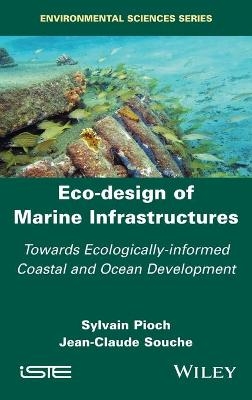
Eco-design of Marine Infrastructures
ISTE Ltd and John Wiley & Sons Inc (Verlag)
978-1-78630-711-8 (ISBN)
Eco-design of Marine Infrastructures provides practical and realistic solutions for delivering projects that strive to minimize negative environmental impacts.
Using case studies and examples, this book presents a toolkit of options, allowing decision makers and planners to see what is possible and to make informed choices about the risks and benefits of eco-design. It is intended for researchers, engineers, students and decision makers, or anyone who is curious to see how nature can be integrated into development.
Sylvain Pioch holds a PhD in Geography and Planning, is an Ecological Engineer (AFIE) and a Senior Lecturer at Paul Valéry University, Montpellier 3, France. He works on the assessment of the impacts of coastal developments, eco-design and ecological maritime restoration. Jean-Claude Souche holds a PhD and is a civil engineer. As well as being a teacher-researcher, he is also Head of the Civil Engineering and Sustainable Building department at IMT Mines Alès, France. He is a specialist in port and coastal civil engineering, and in the eco-design of maritime works and their interactions with their environment.
Foreword ix
Preface xi
Acknowledgments xv
Chapter 1. Principles and Genesis of Maritime Eco-design 1
1.1. Principles of maritime eco-design 2
1.2. Definition of eco-design of marine infrastructures 4
1.3. Japanese inspiration 8
1.3.1. Influence of the Japanese vision for sea-friendly development projects 8
1.3.2. The Japanese Sato-umi 10
1.3.3. Artificial marine habitats: Japanese origin of inspiration for eco-design 11
1.4. Assessing the effects of a project on the environment: the impact study 12
1.4.1. Designing a better project for the environment 14
1.4.2. Informing the administrative authority on the decision to be taken 14
1.5. The “no net loss of biodiversity” objective: a regulatory obligation for developers, an opportunity for eco-design 17
1.6. Specificities of the environmental assessment related to the marine environment: the “natural” public maritime domain concept 19
1.6.1. The natural public maritime domain, an essential concept 19
1.6.2. Managing the marine environment: a necessarily integrated approach 23
Chapter 2. Maritime Civil Engineering 27
2.1. General information 28
2.2. Typology of coastlines 30
2.2.1. Coastal classification and sea-level evolution 30
2.2.2. Sea-level fluctuations and coastline erosion 33
2.2.3. Rocky shores 35
2.2.4. Soft coastlines 36
2.2.5. Fine material shorelines 38
2.2.6. Coral bioconstructed coastlines and mangroves 39
2.2.7. Assessment 41
2.3. Coastal defense works 41
2.3.1. Main transverse structures: groins and jetties 42
2.3.2. Main longitudinal structures: breakwaters and upper beach structures 43
2.4. Port structures 47
2.4.1. Criteria for establishing a port 47
2.4.2. Geographical location 48
2.4.3. Economic criteria 49
2.4.4. Operating principles of ports 51
2.4.5. Typology of port structures 56
2.5. Design approach 59
2.5.1. The design methodology 59
2.5.2. Ocean data 62
2.5.3. Service actions 70
2.5.4. The usual design criteria 73
2.5.5. Geotechnical data 74
2.5.6. Data on construction materials 79
2.5.7. Synthesis 87
Chapter 3. Eco-design of Marine Infrastructures 89
3.1. The evolution of research work towards the eco-design of marine structures 90
3.2. The modernized approach to project management 96
3.2.1. Eco-design actors 101
3.2.2. Development and maturation of an eco-designed development project 103
3.3. The methodological approach to eco-design: responding to the expressed need 109
3.3.1. Eco-design, an adapted technical response for engineers and project managers 110
3.3.2. Eco-design as a lever for modernizing the execution of works 117
3.3.3. Monitoring, control, validation and satisfaction for the user and nature 121
3.4. Infrastructure as a new support for marine life 122
3.4.1. Biophysical data of the environment 123
3.4.2. Integration of the infrastructure into an ecosystem 130
3.4.3. Bio-inspiration and design of eco-designed structures 144
3.5. Eco-design at the material level: the example of concrete 144
3.5.1. A little history 144
3.5.2. Concrete, the state of the art 150
3.5.3. Concrete formulations 156
3.5.4. The integrative eco-design of the performance approach: perspectives 159
Chapter 4. Evidence Through Experience: Examples of Eco-designed Marine Projects 163
4.1. Mayotte submarine pipeline: an initial eco-designed marine structure 167
4.2. Bio-inspiration and nature-based solutions for artificial reef design 177
4.2.1. The value of creating artificial habitats 178
4.2.2. The issue of fish habitat creation 179
4.3. The scope of port eco-design 183
4.3.1. The concept of port eco-design 183
4.3.2. Eco-design of the port of Guilvinec-Lechiagat 185
4.3.3. Ecological structures designed as natural grass beds 186
4.3.4. “Calais Port 2015” port project 187
4.4. Eco-design for coastal protection 191
4.4.1. Beneficial use of coastal sediment transport: the Sand Motor project 192
4.4.2. The experience of the ECOncrete company 194
4.4.3. Landscape redevelopment of the East Darling Harbour waterfront in Sydney 196
4.4.4. CLI’s experience with concrete dike shells: the need for eco-design 198
4.4.5. Eco-design of the Brest harbor breakwater 200
4.5. Biomimetic artificial reefs in Corsica (Ajaccio) 202
4.6. Artificial island eco-design 208
4.6.1. The Monegasque government’s vision for the Principality of Monaco’s offshore extension 208
4.6.2. The genesis of the eco-design of the Monegasque artificial peninsula project 214
4.7. Eco-design of mooring systems 216
4.7.1. Eco-design of moorings for recreational vessels in Guadeloupe 217
4.7.2. Eco-design of moorings for large vessels and yachts as a solution for the protection of the Mediterranean Posidonia meadow 225
4.8. Eco-design of offshore viaduct piles 232
4.9. Offshore wind farm project eco-design: multi-use perspectives 236
Conclusion 239
References 243
Index 259
| Erscheinungsdatum | 07.12.2021 |
|---|---|
| Verlagsort | London |
| Sprache | englisch |
| Maße | 10 x 10 mm |
| Gewicht | 454 g |
| Themenwelt | Technik ► Bauwesen |
| ISBN-10 | 1-78630-711-1 / 1786307111 |
| ISBN-13 | 978-1-78630-711-8 / 9781786307118 |
| Zustand | Neuware |
| Haben Sie eine Frage zum Produkt? |
aus dem Bereich


